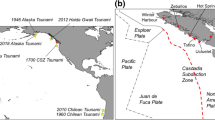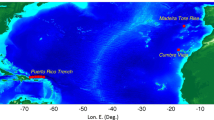Abstract
The tsunami inundation flows on Banda Aceh, Indonesia reached 5 km inland during the December 26, 2004, event and devastated most of the houses, buildings, and infrastructure along the coast and killed more than 167,000 people. The overland flows from the northwest coast and the west coast collided at Lampisang village approximately 3.7 km from Ulee Lheue (northwest coast) and 6.8 km from Lhok Nga (west coast) as reported by survivors. Inundation modeling based on the nonlinear shallow-water wave equations reproduces the inundation pattern and demonstrates a colliding of the overland flows. The model suggests that wave characteristics on the northwest coast of Banda Aceh were different from those on the waves that impacted upon the west coast. The areas, which experienced higher inundation levels, did not always experience greatest overland flow speeds, and the damage areas mostly coincide with the flow speed distribution rather than the runup and inundation depth.





















Similar content being viewed by others
References
Aida I (1978) Reliability of a tsunami source model derived from fault parameters. J Phys Earth 26:57–73
Banerjee P, Pollitz F, Nagarajan B, Burgmann R (2007) Coseismic slip distribution of the 26 December 2004 Sumatra-Andaman and 28 March 2005 Nias Earthquake from GPS static offsets. Bull Seismol Soc Am 97(1A):S86–S102. doi:10.1785/01200506091
Black KP (1983) Sediment transport and tidal inlet hydraulics. PhD thesis, University of Waikato, New Zealand, p 331
Black KP (2001) The 3DD suite of numerical process models. ASR Ltd., PO Box 67, Raglan, p 90
Black KP, Barnett AG (1988) Sediment transport modelling under tidal flows with application in Natural Estuary, IAHR Symposium on mathematical modeling of sediment transport in the Coastal Zone, Copenhagen, p 9
Black KP, Gay SL (1987) Eddy formation in unsteady flows. J Geophys Res 92(C9):9514–9522
Black KP, Gay SL (1989) Reef-scale numerical hydrodynamic modelling developed to investigate crown-of-thorns starfish outbreaks. In: Bradbury R (ed) Acanthaster and the coral reef: a theoretical perspective. Lecture notes in Biomathematics, Springer, pp 120–150
Black KP, Healy TR, Hunter M (1989) Sediment dynamics in the lower section of a mixed sand and shell–lagged tidal estuary. J Coast Res 5(3):503–521
Borrero JC (2005) Field data and satellite imagery of tsunami effects in Banda Aceh. Science 308:1596
Borrero JC, Synolakis CE, Fritz H (2006) Northern Sumatra field survey after the December 2004 great Sumatra earthquake and Indian Ocean tsunami. Earthquake Spectra 22(3):93–104
Borrero JC, Bosserelle C, Prasetya G, Black KP (2007) Using 3DD to model tsunami inundation. In: Proceedings of the Australasian coast and port conference, July 2007. Melbourne, Paper 96, p 6
BRR (Reconstruction and Rehabilitation Agency of Aceh and Nias) (2006) Progress Report Aceh & Nias, two years after the tsunamis, December 2006, p 110
Fritz H, Borrero JC, Synolakis CE, Yoo J (2006) 2004 Indian Ocean tsunami flow velocity measurements from survivors videos. Geophy Res Lett 33:1–5
Fujii Y, Satake K (2007) Tsunami source of the 2004 Sumatra-Andaman earthquake inferred from tide gauge and satellite data. Bull Seismol Soc Am 97(1A):S192–S207. doi:10.1785/0120050613
Grilli ST, Loualalen M, Asavanant J, Shi F, Kirby J, Watts P (2007) Source constraints and model simulation of the December 26, 2004, Indian Ocean Tsunami. J Waterw, Port, Coast Ocean Eng 133:414–429. doi:10.1061/(ASCE)0733-950X(2007)133:6(414)
Jaffe BE, C. Borrero JC, Prasetya GS, Peters P, McAdoo B, Gelfenbaum G, Morton R, Ruggiero P, Higman B, Dengler L, Hidayat R, Kingsley E, Widjo Kongko, Lukijanto, Moore A, Titov V, Yulianto E (2006) The December 26, 2004 Indian Ocean tsunami in Northwest Sumatra and Offshore Islands. Earthquake Spectra 22(3):105–135
Liu PLF, Yeh H, Synolakis CE (2008) Benchmark problems in advance numerical models for simulating tsunami waves and runup. In: Liu PLF, Yeh H, Synolakis CE (eds) Advance in Coastal and Ocean Engineering, Vol 10. pp 223–230
Lundquist CJ, Thrush F, Oldman JW, Senior AK (2004) Limited transport and recolonization potential in shallow tidal estuaries. J Limnol Oceanogr 49(2):386–395
Matsutomi H, Sakakiyama T, Nugroho S, Matsuyama M (2006) Aspects of inundated flow due to the 2004 Indian Ocean tsunami. Coast Eng J 48(2):167–195
Okada Y (1985) Surface deformation due to shear and tensile faults in a half space. Bull Seismol Soc Am 5(4):1135–1154
Paris R, Lavigne F, Wassmer P, Sartohadi J (2007) Coastal sedimentation associated with the December 26 2004 tsunami in Lhok Nga, west Banda Aceh (Sumatra, Indonesia). Mar Geol 238:97–106
Rhie J, Dreger D, Burgmann R, Romanowicz B (2007) Slip of the 2004 Sumatra-Andaman earthquake from joint inversion of long-period global seismic waveforms and GPS static offsets. Bull Seismol Soc Am 97(1A):S115–S127. doi:10.1785/0120050620
Shuterland J, Peet AH, Soulsby RL (2004) Evaluating the performance of morphological models. Coast Eng 51:917–939
Stein S, Okal EA (2005) Speed and size of the Sumatra earthquake. Nature 434(7033):581–582
Subarya C, Clieh M, Prawirodirdjo L, Avouac J, Bock Y, Sieh K, Meltzner A, Natawidjaja D, McCaffrey R (2006) Plate-boundary deformation associated with the great Sumatra-Andaman earthquake. Nature 440:46–51
Synolakis CE (1987) The runup of solitary waves. J Fluid Mech 185:523–545
Synolakis CE, Bernard E (2006) Tsunami science before and beyond Boxing Day 2004. Philos Trans R Soc Lond A 364:2231–2265
Synolakis CE, Kong L (2006) Runup measurements of the December 2004 Indian Ocean Tsunami. Earthquake Spectra 22(3):67–91
Synolakis CE, Okal EA (2005) 1992–2002: perspective on a decade of post tsunami surveys. Adv Nat Technol Hazards 23:1–30
Tadepalli S, Synolakis CE (1994) The runup of N-waves. Proc R Soc Lond A 445:99–112
Tadepalli S, Synolakis CE (1996) Model for the leading waves of tsunamis. Phys Rev Lett 77:2141–2144
Tanioka Y, Kasusose T, Kathiroli S, Nishimura Y, Iwasaki S, Satake K (2006) Rupture process of the 2004 great Sumatra-Andaman earthquake estimated from tsunami waveforms. Earth Planet Space 58:203–209
Titov VV, Synolakis CE (1997) Extreme inundation flows during the Hokkaido-Nansei-Oki tsunami. Geophys Res Lett 24(11):1315–1318
Titov VV, Rabinovich AB, Mofjeld HO, Thomson RE, Gonzalez FI (2005) The global reach of the 24 December 2004 Sumatra tsunami. Science 309:2045
Umitsu M, Tanavud C, Patanakanog B (2007) Effects of landforms on tsunami flow in the plains of Banda Aceh, Indonesia, and Nam Khem, Thailand. Mar Geol 242:141–153
Valee M (2007) Rupture properties of the giant Sumatra earthquake imaged by empirical Green’s function analysis. Bull Seismol Soc Am 97(1A):S103–S114. doi:10.1785/0120050616
Yalciner AC, Perincek D, Ersoy S, Prasetya G, Hidayat R, McAdoo BG (2005) Report on December 26, 2004, Indian Ocean Tsunami, Field Survey on Jan 21–31 at North of Sumatra, ITST of UNESCO IOC, p 18
Acknowledgments
The authors wish to thank anonymous reviewer for a critical review and valuable inputs and comments that improved the manuscript considerably. The numerical model research work had been funded through NZIDRS, New Zealand and the fieldwork funded partly by Tsunami Research Foundation––Indonesia, USGS––NOAA on ITST 1–2. Thanks to Drs. Rahman Hidayat, Dinar C Istiyanto, Widjo Kongko, Lukianto and all ITST Sumatra 2004 team for providing the fieldwork data.
Author information
Authors and Affiliations
Corresponding author
Rights and permissions
About this article
Cite this article
Prasetya, G., Borrero, J., de Lange, W. et al. Modeling of inundation dynamics on Banda Aceh, Indonesia during the great Sumatra tsunamis December 26, 2004. Nat Hazards 58, 1029–1055 (2011). https://doi.org/10.1007/s11069-010-9710-7
Received:
Accepted:
Published:
Issue Date:
DOI: https://doi.org/10.1007/s11069-010-9710-7




